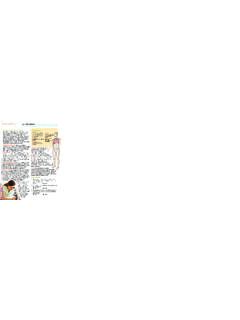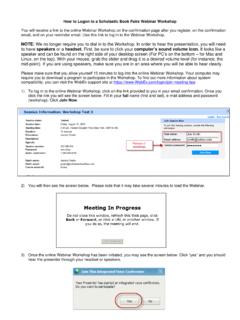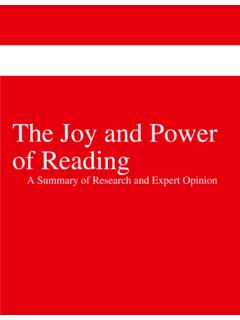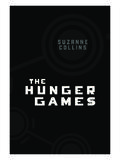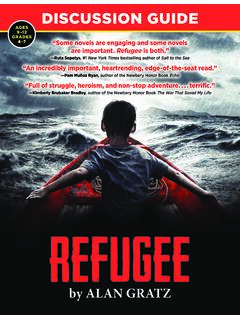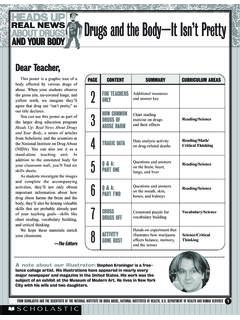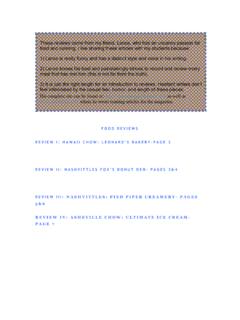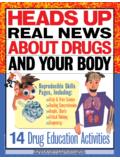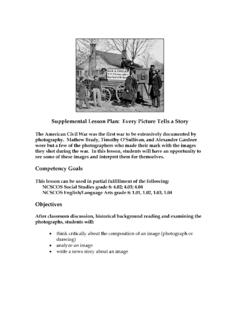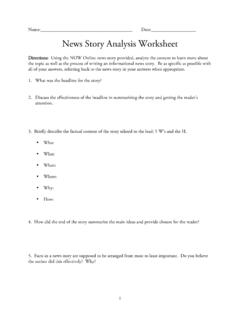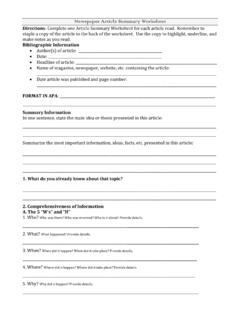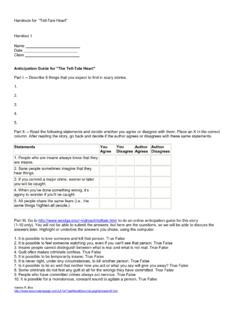Transcription of TEACHER INSTRUCTIONS - Scholastic
1 Generously sponsored bySCHOLASTIC and associated logos are trademarks and/or registered trademarks of Scholastic Inc. All rights reserved. Objective: This lesson will promote understanding about what it means to be news literate and how learning to analyze media reports about current events can foster civic engagement. Time: Two class periods, plus time for the Extension Activity Materials: Decoding the news worksheet , access to a variety of news sources (including, but not limited to, newspapers, newsmagazines, blogs, television broadcasts, radio programs, and online video content), three news items from different sources that report on the same current event, Internet access, paper, pencil or pen Session One INTRODUCTION: Importance of news Literacy1. Write down the phrase civic participation on your whiteboard or chalkboard.
2 Introduce this concept to your class by explaining that civic participation (also called civic engagement) describes the way people involve themselves in their communities to address issues of public Ask students to come up with examples of how people including themselves might practice civic participation. Write these examples on the board under civic participation. (Answers may include activities, such as standing up for civil liberties, voting, volunteering, or joining a community organization.)3. Point out that students may not have considered one particularly significant type of civic participation: becoming knowledgeable about current events and thinking critically about how they are covered by the media. Initiate a class discussion by asking students to consider how understanding the news might impact people s engagement with their communities.
3 4. Explain that on the Internet today people are bombarded with information about what s happening in the world. But not all of that information is reliable. State that students need to cultivate news literacy the ability to judge the trustworthiness of news and its sources in order to separate facts from opinion. Developing this news -gathering skill helps people become responsible consumers of information. 5. Review the following key questions readers/viewers should ask to foster news literacy while examining different news stories: Does the story address: Who? What? Where? When? Why? How? What sources are cited in the story , and are they reputable? Is the person reporting the story biased? Is only one point of view presented? Are the main points of the piece supported by evidence or based on opinion?
4 Does the story leave any questions unanswered? CLASS ASSIGNMENT: Evaluating news Sources1. Divide your class into groups, and distribute the Decoding the news worksheet to each group. Explain that the worksheet contains the questions they just discussed. Students will use them to conduct a thorough review of an actual news Before this lesson, choose a topic currently in the news . Present a short summary of the topic to your class. Then provide students with access to at least five different news sources including, but not limited to, newspapers, newsmagazines, blogs, television broadcasts, radio programs, and online video content. Instruct groups to use the provided sources to find three news stories discussing the given topic. They ll then select one of the items they uncovered and use the worksheet to analyze the information it contains.
5 Review the vocabulary words on the worksheet with students. Encourage them to use these words in the analysis of their findings. 3. After completing the activity, have each group share its findings with the rest of the class. Encourage students to debate the strengths and weaknesses of each news story being critiqued. Challenge them to also provide different perspectives on the group s analysis . TEACHER INSTRUCTIONS Decoding the news Building Savvy Media ConsumersSCHOLASTIC and associated logos are trademarks and/or registered trademarks of Scholastic Inc. All rights reserved. 4. Wrap up the activity by asking students to discuss what they ve learned about evaluating news sources. Have them answer the following questions: Why do you think news literacy is an important skill? What tips can you provide to others to help them become active, rather than passive, readers/viewers/consumers of news ?
6 Do you think being a well-informed citizen would promote better civic participation? Session Two INTRODUCTION: Search for the Truth 1. Engage students in a guided conversation about their class assignment from Session One. Begin by having students discuss any observations they ve made about the content of news they ve seen or read since learning about civic participation. Use the following questions to continue guiding the exchange between students: Has your perspective on what constitutes reliable news changed? Do you think your news literacy has improved? Do you feel like you engage with media differently now? 2. Ask students to consider how they determine whether something is true or not when gathering news . Introduce students to the idea that the truth about a news topic can change over time.
7 As people report on a topic, the event may continue to unfold and more details may be revealed later. Explain that as new evidence and perspectives emerge, what appears to be true about news stories can shift. Ask students whether they can think of examples of news stories where this was the Select three news items that cover the same current event prior to class. It is best that each news item offer a conflicting viewpoint or different details to illustrate how facts can be depicted in multiple ways and how the truth about a topic can change. Provide these sources to students. Have them read/watch the news items and attempt to determine the truth of the topic from the information the sources contain. 4. Instruct students to write a brief summary of the current event from the three news items. It should include an explanation of: How the truth changed or did not change after reading/viewing all three items.
8 How their opinions on the topic changed or did not change after reading/viewing all three items. What new perspectives or biases were introduced as a result of reading/viewing multiple news items rather than one. EXTENSION ACTIVITY: Civic Participation in Action1. Have students continue to explore the concept of truth in the news by asking them to follow a current event of their choosing in real time as it develops. 2. Before assigning this project, decide how long students should follow their topics (for example, one, two, or three weeks). Each week students should keep up with their current events by reading at least two print or online news articles on their topics, as well as viewing video and broadcast news stories. While reading/viewing these stories, they should ask the following questions: What are the main elements of this story ?
9 Who are the relevant people in this story ? Are different sides of the issue given in this story ? What is my opinion on this story ? 3. Explain that students should also conduct substantial research beyond news sources. These sources will help them gather evidence to support their perspectives on the truth about the topic. Tell students that they should search for facts on their topics in a wide number of online sources, via expert interviews ( , students can attempt to connect with a local politician, member of the media, or another source associated with their stories), journal articles, hands-on research, books, and other types of media. Students should record any rele-vant information they find and cite the source where it was At the end of the set research period, students will choose to complete one of the following projects to present their position on their topic.
10 (Note: For civics and history classes, students can choose to enhance their arguments by connecting them with a previously studied constitutional principle, , separation of powers, rule of law, etc.) An editorial article (opinion piece) for a newspaper where they express their personal opinions on the topic. A written interview with an expert on the subject. A radio broadcast script in which they ll inform the public about the details of their INSTRUCTIONSD irections: Research a variety of news sources (newspapers, newsmagazines, blogs, television broadcasts, radio programs, and online video content) to find three news stories on the topic presented by your TEACHER . Use the questions in the chart and the vocabulary list below to evaluate the information from one of these stories. Name: _____Student WorksheetAnalysis QuestionsYour FindingsWhat is the source of the story ?
